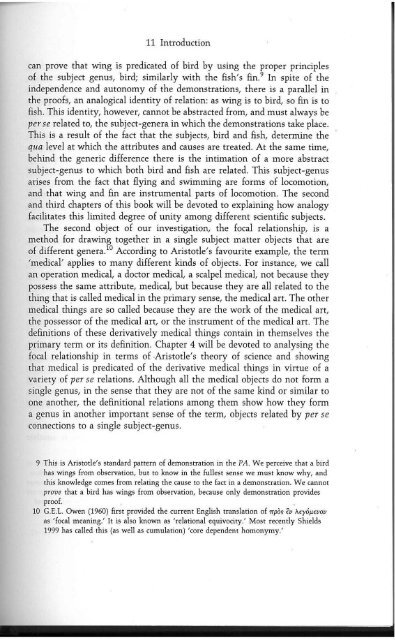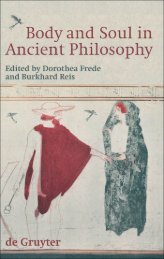Aristotle's Theory Unity of Science
Aristotle's Theory Unity of Science
Aristotle's Theory Unity of Science
Create successful ePaper yourself
Turn your PDF publications into a flip-book with our unique Google optimized e-Paper software.
11 Introductioncan prove that wing is predicated <strong>of</strong> bird by using the proper principles<strong>of</strong> the subject genus, bird; similarly with the fish's fin' In spite <strong>of</strong> theindependence and autonomy <strong>of</strong> the demonstrations, there is a parallel inthe pro<strong>of</strong>s, an analogical identity <strong>of</strong> relation: as wing is to bird, so fin is t<strong>of</strong>ish. This identity, however, cannot be abstracted from, and must always beper se related to, the subject-genera in which the demonstrations take place.This is a result <strong>of</strong> the fact that the subjects, bird and fish, determine thequa level at which the attributes and causes are treated. At the same time,behind the generic difference there is the intimation <strong>of</strong> a more abstractsubject-genus to which both bird and fish are related. This subject-genusarises from the fact that flying and swimming are forms <strong>of</strong> locomotion,and that wing and fin are instrumental parts <strong>of</strong> locomotion. The secondand third chapters <strong>of</strong> this book will be devoted to explaining how analogyfacilitates this limited degree <strong>of</strong> unity among different scientific subjects.The second object <strong>of</strong> our investigation, the focal relationship, is amethod for drawing together in a single subject matter objects that are<strong>of</strong> different genera lO According to <strong>Aristotle's</strong> favourite example, the term'medical' applies to many different kinds <strong>of</strong> objects. For instance, we callan operation medical, a doctor medical, a scalpel medical, not because theypossess the same attribute, medical, but because they are all related to thething that is called medical in the primary sense, the medical art. The othermedical things are so called because they are the work <strong>of</strong> the medical art,the possessor <strong>of</strong> the medical art, or the instrument <strong>of</strong> the medical art. Thedefinitions <strong>of</strong> these derivatively medical things contain in themselves theprimary term or its definition. Chapter 4 will be devoted to analysing thefocal relationship in terms <strong>of</strong> -<strong>Aristotle's</strong> theory <strong>of</strong> science and showingthat medical is predicated <strong>of</strong> the derivative medical things in virtue <strong>of</strong> avariety <strong>of</strong> per se relations. Although all the medical objects do not form asingle genus, in the sense that they are not <strong>of</strong> the same kind or similar toone another, the definitional relations among them show how they forma genus in another important sense <strong>of</strong> the term, objects related by per seconnections to a single subject-genus.9 This is <strong>Aristotle's</strong> standard pattern <strong>of</strong> demonstration in the PA . We perceive that a birdhas wings from obseJVation, but to know in the fullest sense we must know why, andthis knowledge comes from relating the cause to the fact in a demonstration. We cannotprove that a bird has wings from observation, because only demonstration providespro<strong>of</strong>.10 G.E.L. Owen (1960) first provided the current English translation <strong>of</strong> 7rpor tV A.EyOP.EVOVas 'focal meaning.' It is also known as 'relational equivocity.' Most recently Shields1999 has called this (as well as cumulation) 'core dependent homonymy.'





![[Niall_Livingstone]_A_Commentary_on_Isocrates'_Busiris](https://img.yumpu.com/51449110/1/163x260/niall-livingstone-a-commentary-on-isocrates-busiris.jpg?quality=85)

![[Richard_Sorabji]_Self__Ancient_and_Modern_Insigh(BookFi.org)](https://img.yumpu.com/30857691/1/174x260/richard-sorabji-self-ancient-and-modern-insighbookfiorg.jpg?quality=85)





